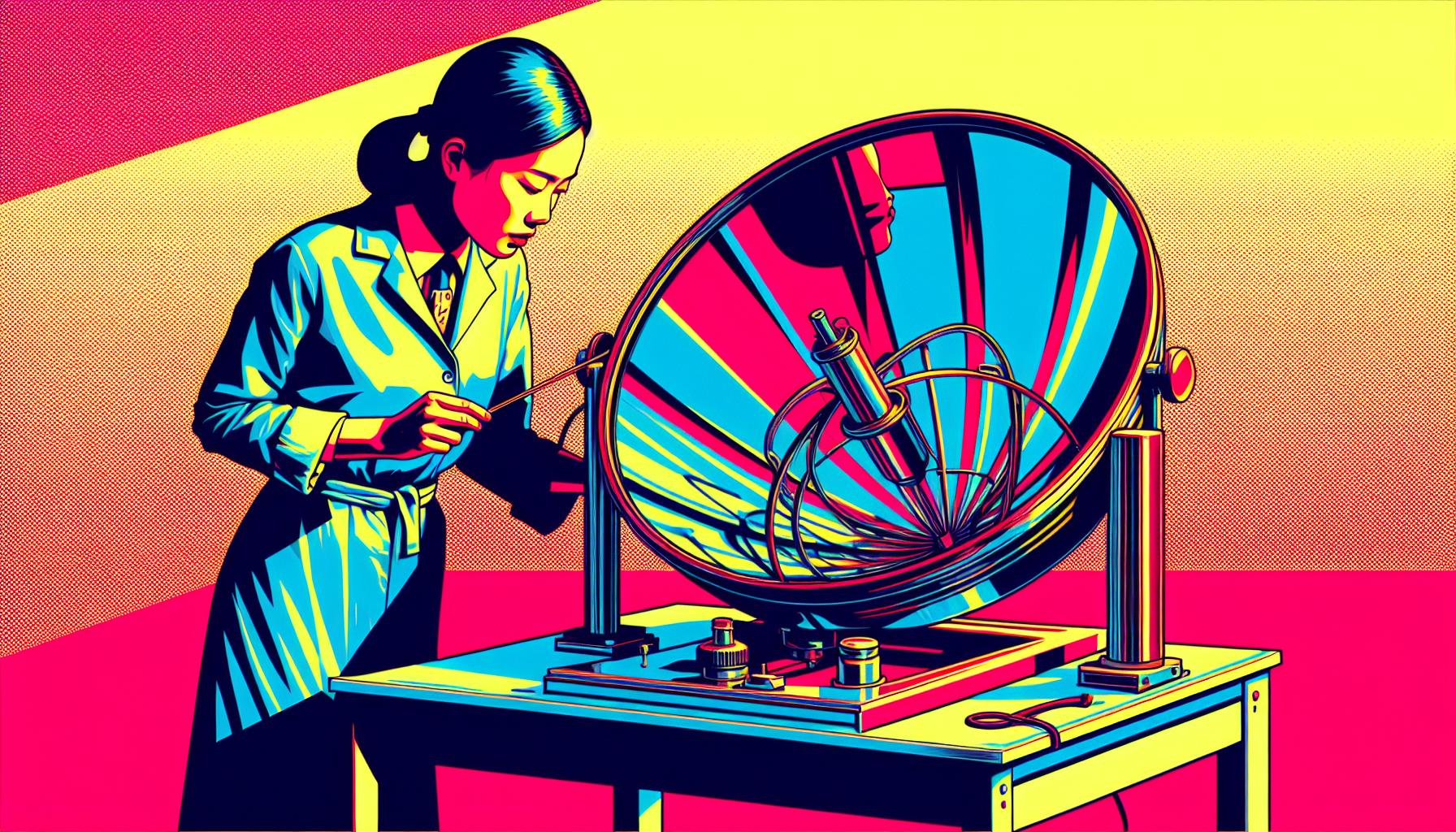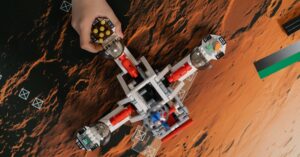This site contains affiliate links to products. I may receive a commission for purchases made through these links.
If you’re like me, you’ve probably spent countless nights gazing up at the stars. But have you ever thought about building your own telescope? It’s not as daunting as it sounds, especially when you can make a parabolic mirror, the heart of the telescope, right at home.
Creating a parabolic mirror is a fascinating project that combines a bit of science, a dash of patience, and a whole lot of precision. It’s a hands-on way to understand the principles of optics and astronomy. So, let’s dive into the world of DIY telescopes and discover how to craft a parabolic mirror.
Remember, the journey to the stars begins on the ground. And in this case, it starts with a homemade parabolic mirror. So, get ready to roll up your sleeves and let’s start our cosmic journey together.
Understanding the Parabolic Mirror
A parabolic mirror is truly an engineering wonder that’s central to the functioning of a telescope. Here, we’ll dive into what makes these mirrors special and why they’re a crucial component in our great universe-exploring tools.
A parabolic mirror – it sounds complex, doesn’t it? But, it’s quite straightforward in operation. Fundamentally, this mirror is designed to collect and focus incoming light waves at one single point. The result? Enhanced clarity and detail that’s hard to beat. Light rays striking the parabolic mirror are reflected to the focus point, irrespective of where on the mirror the light originally landed.
But, why parabolic? Well, the unique shape of the mirror ensures that no matter where the light hits, it’s redirected towards the focal point. A common mirror would scatter light rays while our parabolic wonder keeps them in check, directing each one to the same point. So, you’re not missing any of that celestial glory!
Here’s something interesting. A parabolic mirror is also a reflection of the laws of physics. It embodies a concept known as geometric optics. This principle explains how light travels in straight lines until something intervenes and disrupts its path. And that’s exactly what your homemade parabolic mirror will do – guide the light straight to your eyes, revealing the wonders of the universe in all their glory.
Building a parabolic mirror isn’t just about crafting an instrument to gaze upon the stars, it’s about comprehending the science that makes it possible. As you work on this project, you’ll see firsthand how light bends, changes direction, and ultimately comes into focus. The fundamentals learnt today will not only equip you for creating a top-notch telescope but also offer brilliant insights into the realms of optics and light.
Materials and Tools Needed to Craft Your Parabolic Mirror for Telescopes
But before diving into the process, let’s get a quick overview of what you’ll need. You’ll be surprised to find that the materials required aren’t as outlandish as you might initially think. Most of the items could be found in a typical home or can be conveniently purchased at your local hardware store.
The primary material we’ll be using is a glass or acrylic pane, preferably with a size of around 8″ x 10″. The truth is, what you’re really looking for here isn’t anything fancy — in fact, the simpler, the better. Plain, clear glass with no etching or frosting is what we’re aiming for.
The tools required are pretty straightforward too. Here’s a shortlist:
- Grinding material: Silicon Carbide is my first choice. It serves as an abrasive material for the grinding process.
- Polishing compound: This is essential for achieving that mirror-like finish. Cerium Oxide is a well-known compound in this respect.
- A pitch lap: This tool is specifically designed to polish and smooth out the glass’s surface.
To measure the shape of your mirror accurately during the shaping process, you’ll want an Optical Stands with Dial Indicator. This tool isn’t a must-have but it can make a lot of difference in making your work easier and more accurate.
You’ll also need a Mold to support the glass during the grinding and polishing stages. But don’t sweat it – a piece of circular plywood or even stiff cardboard can work too.
One more thing, remember to keep a bucket of Water close to you. It’ll come in handy – particularly during the grinding phase to help keep dust levels down and the glass cool.
The beauty of this project lies in its simplicity. No need for advanced tools or exotic materials. Everything is basic and that’s exactly the charm of it. Now, let’s move on to understanding how these materials and tools are used to ultimately create a parabolic mirror.
Preparing the Workspace
Before we dive into the step-by-step guide on creating your very own parabolic mirror, it’s crucial to properly organize your workspace. A well-prepared workspace doesn’t only enhance efficiency but also ensures safety during the process. Think of it as the foundation of your project, reliable and ready to support your efforts.
Begin by choosing an area with enough space for maneuvering comfortably – the area must also be clean and well-lit. Adequate lighting is non-negotiable when dealing with intricate projects like this. You don’t want to strain your eyes or make mistakes because of poor visibility.
Next, lay out the necessary materials and tools we discussed in the former section. That includes the glass or acrylic pane, grinding material, polishing compound, pitch lap, an optical stand with a dial indicator, and a mold. Remember, the organization is key to avoid frustration and streamline the process. Lay out your tools and materials in a manner that’ll allow you to locate and access them swiftly.
Keep in mind that this project involves generating a substantial amount of dust and requires the utilization of water to keep the working glass cool. You’d want to protect your area from water and dust damage. I recommend layering your workspace with plastic or newspapers to ensure easy cleanup afterward.
Don’t forget to prepare your safety gear. Handling glass, grinding, and polishing materials can pose risks. So, yes, safety goggles are a must. They’ll protect your eyes from any foreign materials that might fly up during the process. A pair of sturdy gloves will come in handy when handling glass and harsh materials.
Last but not least, ensure you have a comfortable chair to sit on if you plan on working for long hours. The process doesn’t have to a strain on your body!
Designing the Mirror Shape
The first and most crucial part of creating our own parabolic mirror for a telescope is the design of the mirror shape. We don’t just need a mirror; we need a parabolic mirror. Here’s why. On a fundamental level, a parabolic mirror’s concave shape ensures all light entering the mirror – regardless of its angle of incidence – converges at a single focal point. And this is key for capturing crisp, clear, and detailed images of celestial bodies.
Let’s get down to designing the mirror shape. You’ll need to decide on the mirror’s diameter and focal length. In physics and optics, the mirror’s diameter is crucial for the level of detail it can capture. A larger diameter captures more light and thus more detail. Correspondingly, the focal length affects the telescope’s magnifying power. Here’s a quick reference:
| Diameter | Detail |
|---|---|
| Small | Limited Detail |
| Large | High Detail |
| Focal Length | Magnifying Power |
|---|---|
| Short | Low Magnification |
| Long | High Magnification |
Do remember, a larger diameter and a longer focal length would require more grinding work on the glass pane. It’s imperative to strike a balance between your desires for detail and magnification, and the work you’re willing to put into creating the mirror.
Proceed to draw your chosen measurements on the glass pane with a marker. To ensure accuracy, use a ruler and a compass. Once we’ve completed this step, the actual hands-on work begins. In our next section, we’ll delve into grinding and shaping the glass into a perfect parabolic mirror.
Shaping the Mirror with Correct Tooling
After meticulous planning and accurate drawing of measurements, we’re ready to move on to the next critical stage: shaping the mirror. Having the right tools is paramount. In this phase, we are going to use a grinding tool. Ideally, I suggest a steel or ceramic tool since they’re both durable and effective. But what’s even more essential is that our grinding tool matches the diameter of our mirror blank.
Let’s dive a tad deeper into the actual process. The first step is the ‘hogging out’ phase. In this stage, we’ll be removing the majority of the glass to create a rough curve, which forms the initial shape of our parabolic mirror. Don’t worry about achieving perfection at this stage. We want to generate a rough form rather than a finished one.
To undertake this task, we need to place the tool on top of the glass, adding the grinding compound in-between. Safety first! Always remember to wear gloves and eye protection during this process. We grind out the glass by stroking the tool over it back and forth, a process that can take a considerable amount of time.
Moving on, the goal for the next stage, the ‘smoothing out’ phase, is to refine and perfect our mirror’s shape. In this phase, the mirror is placed on top, and the same back-and-forth motion is applied but with a reduced grinding compound. As time progresses, I suggest gradually using finer grinding compounds to maximize the mirror surface’s smoothness and quality.
It’s essential to ensure the grinding process is even across the surface. We don’t want uneven grinding as it would distort the light and compromise the mirror’s functionality, leading to a lesser quality viewing experience.
Do keep in mind that the process of grinding and smoothing is laborious, requiring patience and precision. But with the right tools and plenty of time, the detailed images that a perfectly shaped parabolic mirror can exhibit are truly unmatched. Our effort will definitely pay off when we start witnessing the vibrant flora of our cosmos in high detail and clarity.
Let’s ready ourselves for our next stage: Polishing and Finishing the Mirror.
Polishing the Mirror Surface
Upon completion of the ‘hogging out’ and ‘smoothing out’ phases, we can move on to one of the most critical steps in creating a parabolic mirror – polishing. Polishing isn’t just about giving your mirror a shiny look; it’s about refining the surface to a level that allows rays of light to be precisely focused onto a single point.
Polishing differs significantly from grinding. Whereas grinding seeks to build the parabolic shape and remove material, polishing doesn’t take off much material. Rather, it removes the smallest imperfections left behind by grinding tools. It’s the small details that make the difference between an exceptional mirror and just a good one.
For polishing, I use a polishing tool, which I prepare by grooving in channels. This tool should match your mirror surfaces. Remember, efficient polishing requires a tool that uniquely fits your mirror. Always ensure the tool fits appropriately.
The polishing compound of choice is cerium oxide, a common mineral that’s effective for giving glass a smooth finish. A drop of water creates a slurry with the cerium oxide, and it’s this mixture that brings about the high reflectivity needed for stellar observation.
The process is labor-intensive and time-consuming, demanding a high degree of patience and perseverance. But I can assure you the payoff is fantastic. After hours of polishing, running the tool across the mirror surface repetitively, I start to observe an unmistakable shine, which is a clear indication that we’re making great progress.
Your final mirror shall end up smooth to the level of a few millionths of an inch. It’s an amazing engineering feat but equally a remarkable scientific achievement, giving you an unmatched experience of viewing the cosmos.
As polishing transitions you closer to crafting your perfect telescope mirror, it’s important to prioritize quality and precision. With the hard work of grinding behind us, take the time to ensure the best result here. Enjoy the process, and let the sky be closer to your fingertips.
Testing the Mirror
Once you’ve devoted countless hours polishing the mirror to a near perfect shape, it’s time to test its functionality. Testing the mirror is equally as important as making it, as it allows you to see any possible defects in your work that need correction.
The focus here is on the use of the ‘Foucault test’, a widely accepted method of checking the mirror’s shape. Named after the physicist Léon Foucault, you’ll need some specifically designed equipment for this test, such as a razor blade, an LED light, and a viewing eyepiece.
Setting Up the Foucault Test
Setting up the Foucault test may take some effort, but it’s well worth it. First, assemble your testing stand, ensuring the LED light source aligns perfectly with the razor blade and the viewing eyepiece. Be sure to adjust the stand so that it’s directly facing your mirror, with the knife-edge of the blade intersecting the reflected light.
One crucial tip in this process is to make sure everything is perfectly aligned to ensure accuracy. Remember, the goal here is to ensure the rays from every point on your mirror are all precisely focused to a single point.
Conducting the Foucault Test
When conducting the test, your task is to move the razor blade edge into the converging cone of light reflected by your mirror. You’ll notice that the mirror starts to appear shadowed part by part, which is exactly what you want. Your job is to note these shadows and the order in which they appear.
If done correctly, a perfectly made parabolic mirror will show you a unique shadow pattern. Comparing this pattern with standard diagrams allows you to spot possible errors in your mirror’s shape. Any deviations you spot are clear indicators that some areas of the mirror need more grinding or polishing.
Conclusion
Crafting a parabolic mirror for a telescope is a task that requires precision and patience. It’s crucial to get the mirror shape just right and to choose the appropriate diameter and focal length. But it doesn’t end there. The Foucault test is a vital part of the process, ensuring that all rays from the mirror focus accurately to a single point.
By comparing shadow patterns with standard diagrams, you can spot any errors in the mirror’s shape. So, don’t skip this step. With careful attention to detail, you’ll be on your way to creating a high-quality parabolic mirror that’ll enhance your stargazing experience. Here’s to clear skies and sharp views!
You may also like:




